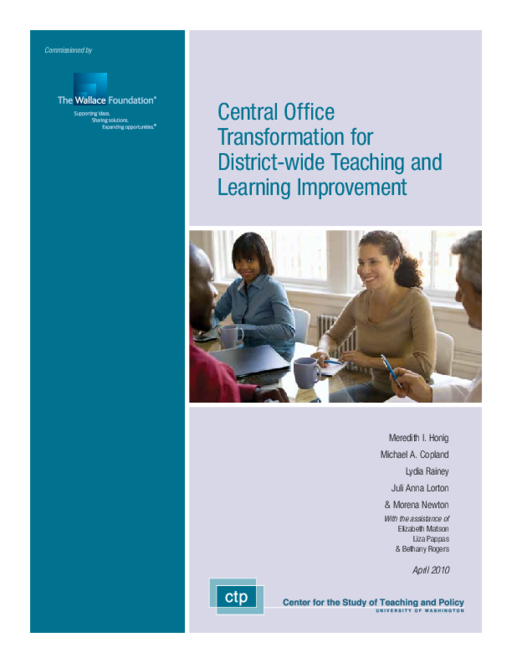- Author(s)
- Meredith I. Honig, Michael A. Copland, Lydia Rainey, Juli Anna Lorton, and Morena Newton
- Publisher(s)
- Center for the Study of Teaching and Policy at the University of Washington
Research Approach
The researchers designed their data collection instruments and framed their analytic work using a conceptual framework derived from socio-cultural learning theory (e.g., Lave, 1998; Rogoff, 1994; Tharp & Gallimore, 1991; Wenger, 1998) and organizational learning theory (e.g., Levitt & March, 1998). They chose these strands of learning theory, in part, because recent studies of school district central offices, including some studies of our own, had productively framed central office administrators’ participation in educational improvement as a challenge of central office learning.
Data Collection
Observations of how central office transformation unfolded in real time proved especially important to the study’s attempt to focus on central office administrators’ daily work. In each school district, the researchers took advantage of different observation opportunities. In Atlanta, they sampled a selection of central office administrators’ work days and in each instance shadowed them throughout the entire day. During shadowing observations they wrote notes in long hand and, periodically throughout the day, typed elaborated field notes that included mostly rich description punctuated with direct quotes. Because they were trying to capture the full breadth of central office administrators’ work, they wrote highly descriptive notes about all the activities we observed while shadowing. When possible, they taped conversations between central office administrators and school principals that happened to occur during their shadowing observation.
In New York City, the Empowerment Schools Organization (ESO) convened key central office staff (the network leaders who worked in direct learning partnerships with principals) twice each month for at least two hours to discuss the central 130 Central Office Transformation for District-wide Teaching and Learning Improvement office transformation process and to engage ESO staff in conversations about how to improve the quality of their work to support principals. The authors contracted with two field researchers who observed virtually all of these meetings during our study period and produced verbatim transcripts of conversations during those meetings. The notes were so detailed that most totaled over 50 single-spaced pages per meeting. The New York field researchers also sampled meetings of other central office administrators and a council of school principals convened by ESO leaders to provide input on the central office’s work.
Similarly, in Oakland the researchers regularly observed a series of central office meetings relevant to the central office transformation process. An on-site field researcher constructed verbatim transcripts of virtually all twice-monthly meetings of the Education Leadership Organization (ELO), which convened the Network Executive Officers (NExO) who worked directly with school principals on their instructional leadership practice.
Interviews
The researchers conducted in-depth, semi-structured interviews with central office administrators, school principals, and representatives from outside organizations involved in, or otherwise in a position to comment on, the central office transformation effort (e.g., school reform support organizations, foundations). They interviewed central office staff most centrally involved in the central office transformation process an average of three-four times per respondent. In all, they conducted 282 interviews with 162 respondents. In the interviews they probed for concrete, albeit self-report, data on central office administrators’ actual work experiences.
Documents
Various documents helped the researchers understand the design of the central office transformation effort at each site, communication and other dimensions of the relationships between central office administrators and school principals, and how central office administrators worked with school principals to improve their instructional leadership practice. For example, central office administrators generated curricular materials or material they refer to as “tools” (see Chapter 2). They focused their collection of documents on those that provided some evidence of how central office administrators worked with schools on teaching and learning improvement as well as documents that described the overall central office transformation process and its underlying rationale.


